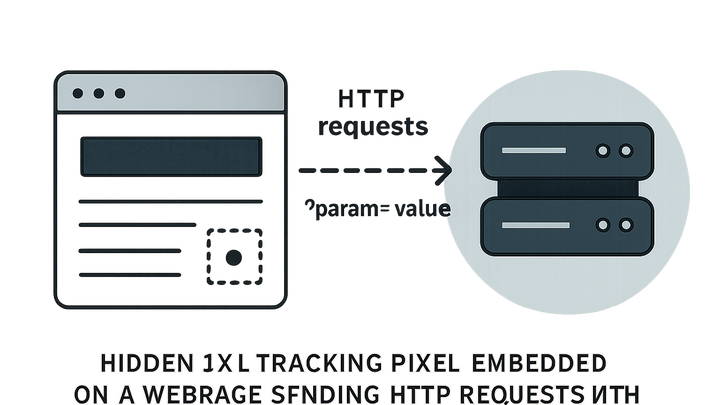Published on 2025-06-22T04:26:09Z
What is a Pixel in Web Analytics? Examples with GA4 & PlainSignal
In web analytics, a pixel - also known as a web beacon or tracking pixel - is a tiny, often 1x1 transparent image embedded in web pages or emails to collect data on user interactions. When the page loads, the browser requests the pixel from the analytics server, sending along query parameters that capture information such as page URL, referrer, user agent, and unique identifiers. Analytics platforms like Google Analytics 4 (GA4) and PlainSignal use pixels to measure pageviews, sessions, and custom events. Pixels are lightweight, easy to deploy, and compatible across browsers and devices. However, they raise important privacy considerations related to cookies, user consent, and regulatory compliance.
Pixel
A 1x1 transparent image embedded in web pages to collect user interaction data via HTTP requests for analytics.
What is a Pixel?
A pixel, or web beacon, is a small transparent image used in web analytics to collect data without affecting the user experience. It operates by embedding a 1x1 image in HTML or CSS and triggering an HTTP request when the page loads.
-
Web beacon definition
Also known as a tracking pixel, it’s usually a 1x1 pixel image embedded in HTML or CSS that triggers a request to an analytics endpoint.
-
Invisible image
It’s transparent to the user, so it doesn’t alter the page layout.
-
Data carrier
The request URL carries query string parameters with tracking data.
-
-
Use cases
Commonly used for pageview tracking, email open measurement, and retargeting audiences.
-
Pageview tracking
Records page loads and user sessions.
-
Email analytics
Detects when an email has been opened.
-
How Pixels Work
When a user visits a webpage with a pixel, the browser requests the pixel file, sending along data to the analytics server. The server logs the request and processes the query parameters into meaningful metrics. This all happens in milliseconds and is invisible to the end user.
-
Http request mechanism
The pixel triggers an HTTP GET request to the analytics endpoint, often disguised as an image file request.
-
Query parameters
Key-value pairs appended to the request URL containing user and session data.
-
Headers
Browser headers like User-Agent and Referer help contextualize the data.
-
-
Server-side logging
The analytics server receives the request, parses the parameters, and logs the event into its database.
-
Parsing
Extracts values from the URL for processing.
-
Storage
Stores the data in structured tables or event streams.
-
Pixel vs Tag
Pixels are simple image-based trackers, while tags are JavaScript snippets that offer more functionality. Tag management systems centralize control, enabling dynamic configuration and versioning. Choosing between them depends on your needs for flexibility, performance, and maintenance.
-
Pixel-based tracking
Relies on simple image requests and URL parameters. Pros: lightweight, easy to deploy. Cons: limited flexibility, harder to update.
-
Simplicity
No JavaScript execution or dependency.
-
Maintenance
Updates require code changes on every page.
-
-
Tag management systems
Use a container snippet to manage multiple tags and pixels from one interface. Pros: centralized control, versioning, conditional triggers. Cons: adds complexity and slight performance overhead.
-
Version control
Rollback or publish changes across all pages instantly.
-
Conditional loading
Load tags based on user actions or specific URLs.
-
Implementing a Pixel: Examples
Let’s look at how to implement pixels in GA4 and PlainSignal.
-
Google analytics 4 pixel
Embed the following global site tag on every page to enable GA4 tracking:
<!-- Google tag (gtag.js) --> <script async src="https://www.googletagmanager.com/gtag/js?id=GA_MEASUREMENT_ID"></script> <script> window.dataLayer = window.dataLayer || []; function gtag(){dataLayer.push(arguments);} gtag('js', new Date()); gtag('config', 'GA_MEASUREMENT_ID'); </script> -
PlainSignal cookie-free pixel
A privacy-focused, cookie-free analytics pixel. Add this snippet before the closing
</head>tag:<link rel="preconnect" href="//eu.plainsignal.com/" crossorigin /> <script defer data-do="yourwebsitedomain.com" data-id="0GQV1xmtzQQ" data-api="//eu.plainsignal.com" src="//cdn.plainsignal.com/plainsignal-min.js"></script>
Privacy Considerations and Cookie-Free Analytics
Pixels traditionally relied on cookies for user identification. Modern solutions like PlainSignal avoid cookies and fingerprinting to enhance privacy and comply with regulations like GDPR and CCPA. However, you should still obtain user consent and ensure data minimization.
-
Cookie-free tracking
Uses non-cookie identifiers and aggregates data to avoid storing personal identifiers.
-
Regulatory compliance
Ensure transparent data processing and user consent. Use consent management platforms and privacy banners.
-
Gdpr
Requires explicit consent for personal data processing in the EU.
-
Ccpa
Grants California residents rights over their data.
-
